Bo Qian
MultiMedEdit: A Scenario-Aware Benchmark for Evaluating Knowledge Editing in Medical VQA
Aug 09, 2025Abstract:Knowledge editing (KE) provides a scalable approach for updating factual knowledge in large language models without full retraining. While previous studies have demonstrated effectiveness in general domains and medical QA tasks, little attention has been paid to KE in multimodal medical scenarios. Unlike text-only settings, medical KE demands integrating updated knowledge with visual reasoning to support safe and interpretable clinical decisions. To address this gap, we propose MultiMedEdit, the first benchmark tailored to evaluating KE in clinical multimodal tasks. Our framework spans both understanding and reasoning task types, defines a three-dimensional metric suite (reliability, generality, and locality), and supports cross-paradigm comparisons across general and domain-specific models. We conduct extensive experiments under single-editing and lifelong-editing settings. Results suggest that current methods struggle with generalization and long-tail reasoning, particularly in complex clinical workflows. We further present an efficiency analysis (e.g., edit latency, memory footprint), revealing practical trade-offs in real-world deployment across KE paradigms. Overall, MultiMedEdit not only reveals the limitations of current approaches but also provides a solid foundation for developing clinically robust knowledge editing techniques in the future.
Decentralization of Generative AI via Mixture of Experts for Wireless Networks: A Comprehensive Survey
Apr 28, 2025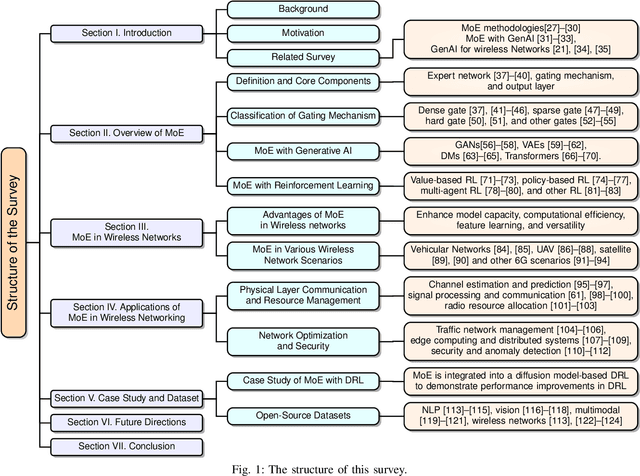
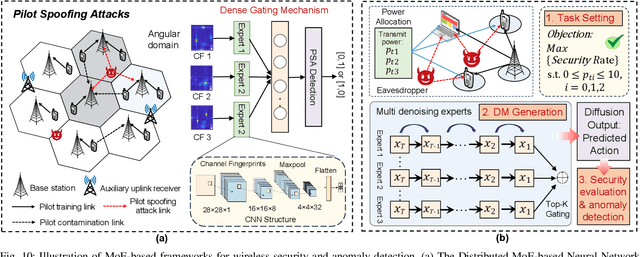
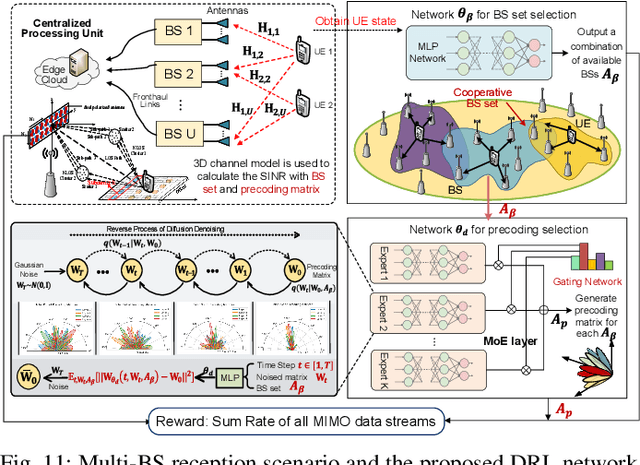
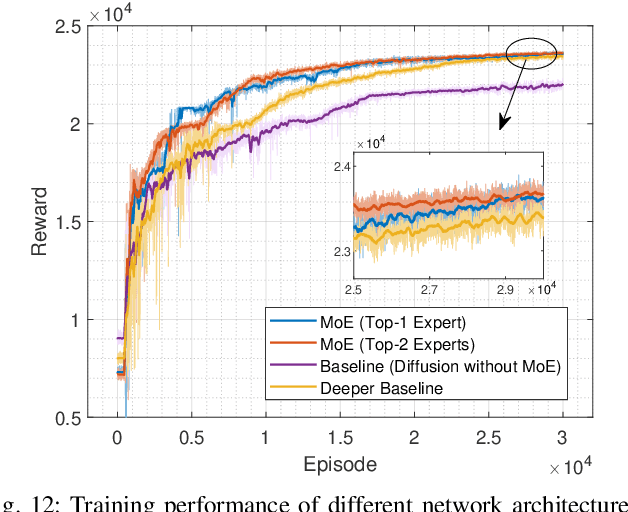
Abstract:Mixture of Experts (MoE) has emerged as a promising paradigm for scaling model capacity while preserving computational efficiency, particularly in large-scale machine learning architectures such as large language models (LLMs). Recent advances in MoE have facilitated its adoption in wireless networks to address the increasing complexity and heterogeneity of modern communication systems. This paper presents a comprehensive survey of the MoE framework in wireless networks, highlighting its potential in optimizing resource efficiency, improving scalability, and enhancing adaptability across diverse network tasks. We first introduce the fundamental concepts of MoE, including various gating mechanisms and the integration with generative AI (GenAI) and reinforcement learning (RL). Subsequently, we discuss the extensive applications of MoE across critical wireless communication scenarios, such as vehicular networks, unmanned aerial vehicles (UAVs), satellite communications, heterogeneous networks, integrated sensing and communication (ISAC), and mobile edge networks. Furthermore, key applications in channel prediction, physical layer signal processing, radio resource management, network optimization, and security are thoroughly examined. Additionally, we present a detailed overview of open-source datasets that are widely used in MoE-based models to support diverse machine learning tasks. Finally, this survey identifies crucial future research directions for MoE, emphasizing the importance of advanced training techniques, resource-aware gating strategies, and deeper integration with emerging 6G technologies.
Feedback-Free Resource Scheduling: Towards Flexible Multi-BS Cooperation in FD-RAN
Feb 25, 2025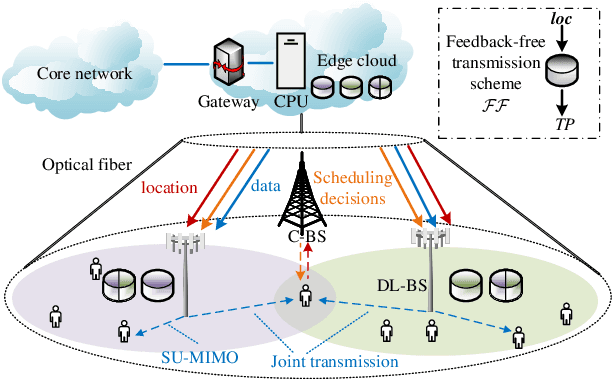

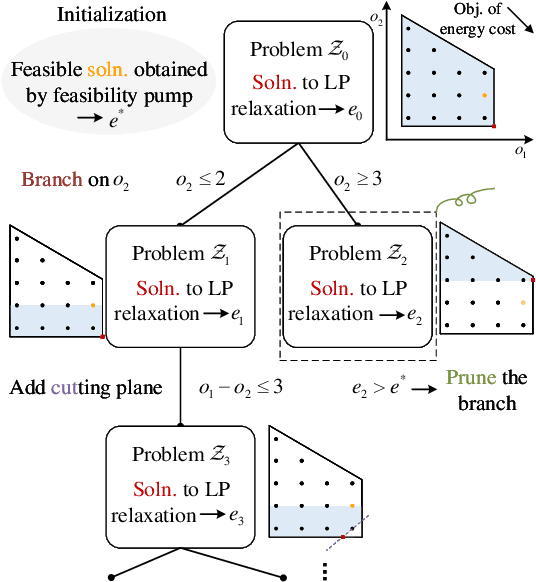
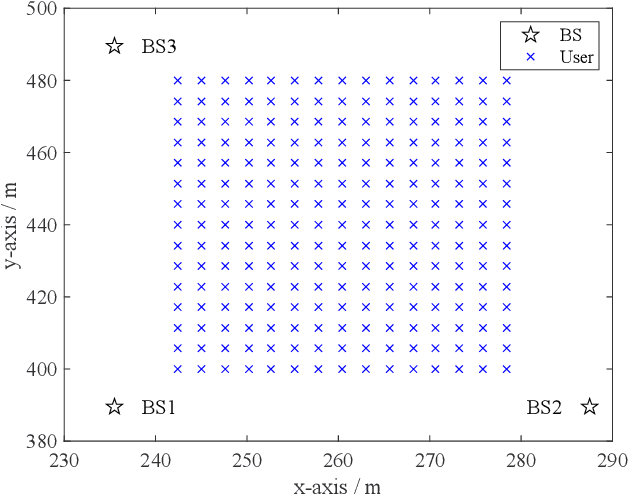
Abstract:Flexible cooperation among base stations (BSs) is critical to improve resource utilization efficiency and meet personalized user demands. However, its practical implementation is hindered by the current radio access network (RAN), which relies on the coupling of uplink and downlink transmissions and channel state information feedback with inherent issues such as overheads and delays. To overcome these limitations, we consider the fully-decoupled RAN (FD-RAN), in which uplink and downlink networks are independent, and feedback-free MIMO transmission is adopted at the physical layer. To further deliver flexible cooperation in FD-RAN, we investigate the practical scheduling process and study feedback-free downlink multi-BS resource scheduling. The problem is considered based on network load conditions. In heavy-load states where it is impossible for all user demands to be met, an optimal greedy algorithm is proposed, maximizing the weighted sum of user demand satisfaction rates. In light-load states where at least one solution exists to satisfy all user demands, an optimal two-stage resource allocation algorithm is designed to further minimize network energy consumption by leveraging the flexibility of cooperation. Extensive simulations validate the superiority of proposed algorithms in performance and running time, and highlight the potential for realizing flexible cooperation in practice.
Multi-Weather Image Restoration via Histogram-Based Transformer Feature Enhancement
Sep 10, 2024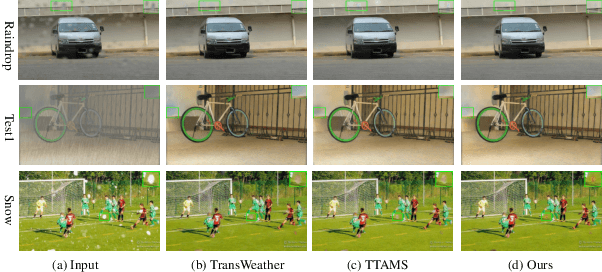



Abstract:Currently, the mainstream restoration tasks under adverse weather conditions have predominantly focused on single-weather scenarios. However, in reality, multiple weather conditions always coexist and their degree of mixing is usually unknown. Under such complex and diverse weather conditions, single-weather restoration models struggle to meet practical demands. This is particularly critical in fields such as autonomous driving, where there is an urgent need for a model capable of effectively handling mixed weather conditions and enhancing image quality in an automated manner. In this paper, we propose a Task Sequence Generator module that, in conjunction with the Task Intra-patch Block, effectively extracts task-specific features embedded in degraded images. The Task Intra-patch Block introduces an external learnable sequence that aids the network in capturing task-specific information. Additionally, we employ a histogram-based transformer module as the backbone of our network, enabling the capture of both global and local dynamic range features. Our proposed model achieves state-of-the-art performance on public datasets.
Multiple weather images restoration using the task transformer and adaptive mixup strategy
Sep 05, 2024Abstract:The current state-of-the-art in severe weather removal predominantly focuses on single-task applications, such as rain removal, haze removal, and snow removal. However, real-world weather conditions often consist of a mixture of several weather types, and the degree of weather mixing in autonomous driving scenarios remains unknown. In the presence of complex and diverse weather conditions, a single weather removal model often encounters challenges in producing clear images from severe weather images. Therefore, there is a need for the development of multi-task severe weather removal models that can effectively handle mixed weather conditions and improve image quality in autonomous driving scenarios. In this paper, we introduce a novel multi-task severe weather removal model that can effectively handle complex weather conditions in an adaptive manner. Our model incorporates a weather task sequence generator, enabling the self-attention mechanism to selectively focus on features specific to different weather types. To tackle the challenge of repairing large areas of weather degradation, we introduce Fast Fourier Convolution (FFC) to increase the receptive field. Additionally, we propose an adaptive upsampling technique that effectively processes both the weather task information and underlying image features by selectively retaining relevant information. Our proposed model has achieved state-of-the-art performance on the publicly available dataset.
DRAC: Diabetic Retinopathy Analysis Challenge with Ultra-Wide Optical Coherence Tomography Angiography Images
Apr 05, 2023



Abstract:Computer-assisted automatic analysis of diabetic retinopathy (DR) is of great importance in reducing the risks of vision loss and even blindness. Ultra-wide optical coherence tomography angiography (UW-OCTA) is a non-invasive and safe imaging modality in DR diagnosis system, but there is a lack of publicly available benchmarks for model development and evaluation. To promote further research and scientific benchmarking for diabetic retinopathy analysis using UW-OCTA images, we organized a challenge named "DRAC - Diabetic Retinopathy Analysis Challenge" in conjunction with the 25th International Conference on Medical Image Computing and Computer Assisted Intervention (MICCAI 2022). The challenge consists of three tasks: segmentation of DR lesions, image quality assessment and DR grading. The scientific community responded positively to the challenge, with 11, 12, and 13 teams from geographically diverse institutes submitting different solutions in these three tasks, respectively. This paper presents a summary and analysis of the top-performing solutions and results for each task of the challenge. The obtained results from top algorithms indicate the importance of data augmentation, model architecture and ensemble of networks in improving the performance of deep learning models. These findings have the potential to enable new developments in diabetic retinopathy analysis. The challenge remains open for post-challenge registrations and submissions for benchmarking future methodology developments.
 Add to Chrome
Add to Chrome Add to Firefox
Add to Firefox Add to Edge
Add to Edge